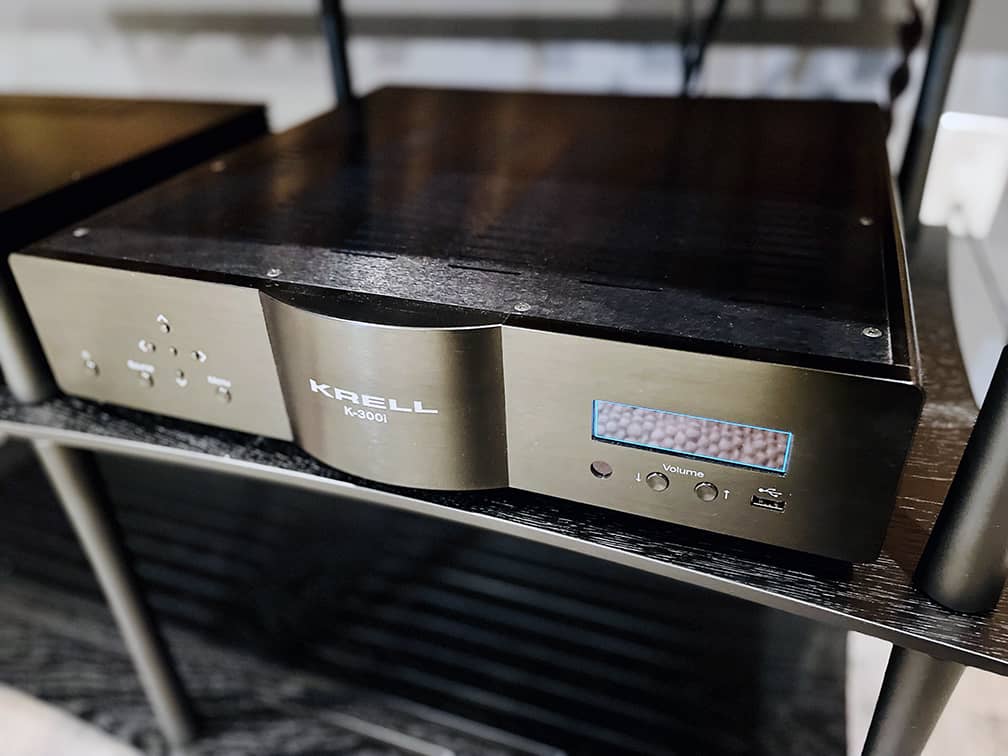The Legacy of Krell: A Deep Dive Into Class A Amplifiers and Modern iBias Technology

When a company’s reign of excellence stretches for decades in the HiFi audio industry, those intimately involved in the second-hand market are able to develop a clearer perspective than most.
We have bought, sold and listened to hundreds of Krell products over the years. We’ve never been unimpressed. We’ve been blown away with recent exposure to their latest lineup, which features a number of innovations along with their trademark craftsmanship and storied devotion to high performance sound.
The public story surrounding Krell in recent years has involved ownership changes, ups and downs, reinvestment and redirection. But from our perspective the brand Krell has always remained Class A in many senses of the term.
Before getting into the new directions, it is worthwhile to take a look at some of the notable products and achievements from Krell throughout the years. These are just a few favorites in the company’s staggering legacy of products, but they tell the true story of one of America’s most iconic HiFi brands better than any kind of gossip tidbit or solitary review could.
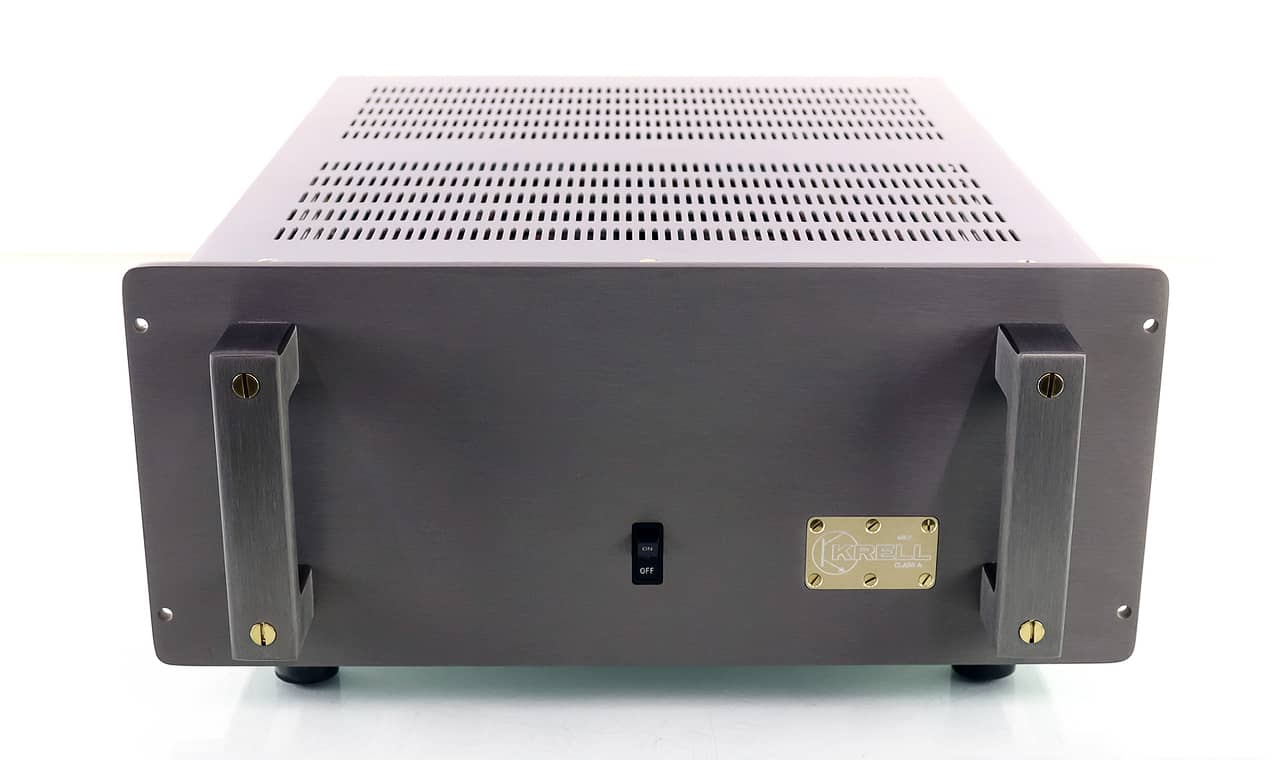 It all started in 1981 with the KSA-100 (the Mk 2 version of which can be seen to the right). The Krell Stereo Amplifier delivered 100 wants of Class A power; an unheard of output for the time. Even companies later known for their output power and heft, like Mark Levinson and Threshold, were producing less than 50 watts per channel back then.
It all started in 1981 with the KSA-100 (the Mk 2 version of which can be seen to the right). The Krell Stereo Amplifier delivered 100 wants of Class A power; an unheard of output for the time. Even companies later known for their output power and heft, like Mark Levinson and Threshold, were producing less than 50 watts per channel back then.
In addition to its unmatched Class A output, the KSA-100 featured another design philosophy that would come to exemplify the Krell brand. The power supply of the amplifier and the output stage were so overbuilt that the machine was capable of driving almost any load (speaker impedance). Yes, it put out 100 watts into 8 Ohms, but amazingly, it was also capable of dumping nearly 1600 watts into a 1 Ohm load. This kind of “load agnostic” design would lead early Krell designs to be paired with the more difficult speakers of the time, like those from ribbon speaker manufacturer Apogee.
Truly, the KSA-100 was a groundbreaking product in the market at a time where just a handful of other Class A amplifiers were available. None of which could boast its output power and sheer durability, and none of which matched its liquid and dynamic sound – another hallmark of the Krell experience.
Throughout the first years, Krell tweaked, refined and reimagined its approach from the original KSA-100 into products like the KSA-50, KSA-100S, KSA-150, KSA-200B, KSA-250 and many more.
Class A is a way to run an amplifier’s output circuit so that its maximum idle current, or “bias” is reached the whole time it’s on, regardless of the level of the input signal. This means it dissipates its maximum amount of heat at all times, which is why these types of amps appear to be mostly made of heat sink fins.
There is something alluring about the sound of Class A amplifiers, and despite their energy usage and heat dissipation this has kept them relevant in the audiophile hobby. Krell states that “Class A designs are the most musically accurate circuit topology available,” and few would disagree. Brands like Threshold, Luxman, Pass Labs, First Watt, Krell and others have either continued to produce class A amplification, or in the least focused on maintaining high amounts of Class A output in their A/B designs.
An A/B design delivers its first number of watts in Class A, where all of the output transistors draw their maximum current, before switching to Class B where only half do. The point at which this switch occurs is decided by the designer, and has to do with the amount of heat dissipation permitted by the chassis. Bigger amplifiers with thicker and more plentiful aluminum fins and heat sinks allow for more dissipation and therefore more Class A wattage, but the brightest minds in audio design were always looking for a way to extend the A region without requiring the costly, heavy and extremely large heat-removing elements.
Though not their first attempt, the notable KST-100 produced in the beginning of the 1990s had Krell zeroing in on how to best deliver Class A while maintaining some reasonable energy usage. The 100-watt A/B amplifier operated in Class A for the first 50 watts, which is much more than most amplifiers of this design, and more than enough for most speaker demands and listening levels.
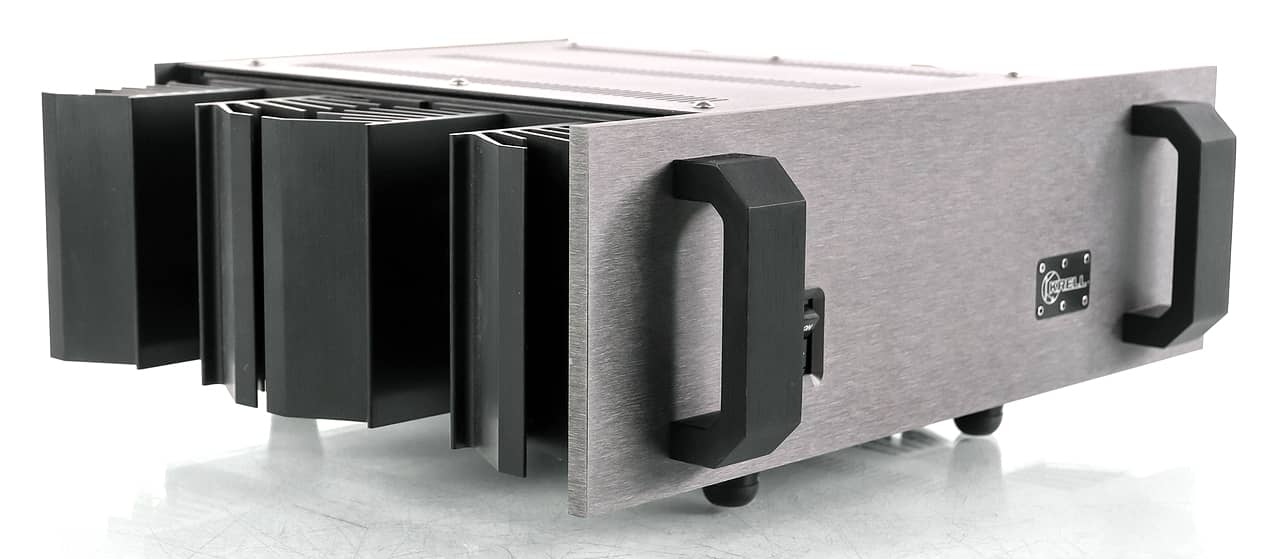
KST-100 amplifier
But down the road, a truly monumental design would come out of the engineering lab. The Krell Audio Standard, released in 1993, expertly personified the power and excess of a Class A approach while continuing the scientific approaches to save energy. Each mono a two-chassis affair, the $35,000 duo of mono Class A amplifiers weighed a collective 400lbs give or take. Classic Krell.
Notable innovations appearing in the statement KAS amps were the “Anticipation” circuit and the “Sustained Plateau” bias circuitry. The former looked ahead in the music signal and adjusted the power supply output to suit peaks when they happened; the latter adjusted the output bias across several preset levels for short periods of time. This was a wildly creative approach back then, and formed the basis for Krell’s modern day iBias technology.
Sustained Plateau was born from an epiphany of Krell’s lead designer and principal owner Dan D’Agostino, and implemented by the current head of engineering, David Goodman. They noticed that high current Class A load requirements showed up only briefly in the varying landscape of real music, and thought that allowing the amplifier’s bias to rise up for periods of 20-60 seconds at a time was a useful way to keep the amp operating in Class A while keeping current output and idle current managed.
Years later, not content with the merely incredible results from the Audio Standard, Krell went on to build the Krell Master Reference amplifiers and subwoofer. The $150K-a-pair amps, of which only 50 were made, offered the best of what lead designer Dan D’Agostino and his 11 or so principal engineers could accomplish, without restriction. They featured Krell’s patented Current Drive amplification, improved Sustained Plateau Bias output scheme and employed the new CAST connection method which made it a product that is still revered in the HiFi audio hall of fame.
Krell released the statement amps and started to dip their toes into the subwoofer market at the same time. Their Master Reference sub was a $40K powerhouse that weighed over 400lbs and is still considered one of the finest subwoofers ever made. Completely composed of aircraft aluminum and fitted with a roughly 2,600-watt linear amplifier, the Master Reference sub used custom JL Audio drivers and an in-house-designed version of servo-control to give the monolithic sub nearly 120dB of output at 20Hz.
Eventually, Krell moved into speaker creation. D’Agostino and his team had some prior experience with advanced crossover design, and Krell’s ability to manufacture high performance metal enclosures with extreme precision led to their first product in that market sector, the LAT-1. LAT stood for Lossless Acoustic Transducer, and employed a highly-engineered fully aluminum cabinet which was said to be one of the most inert on the market. Subsequent notables throughout the years from Krell’s speaker division included the $64K Modulari Duo statement pieces and the relatively more affordable $11K Resolution 1, of which Stereophile’s Michael Fremer was particularly fond.
Later on in the 2000s during another period of reinvention, Krell developed the aptly-named Evolution One and Two – a set of mono amps and mono preamps respectively. These took on a less hulking look than prior Krell designs, trading muscular handles and imposing heat sink fins for polished aluminum and the now trademark curved front panel. Paired with the “evolution” of their LAT speakers, the LAT 1000, the sound of the One and Two led a 6 Moons reviewer in attendance at a dealer demonstration to express the following:
“Even at quiet levels, the Evolution Series system performed with such a sustained dynamic profundity and sense of absolute power, one could only listen in drop-jawed wonder. Every acoustic bass riff, snare drum crack and smoky female jazz vocal emanated as if from a veritable Mount Olympus of audio bravado. This was high end as dawn-of-creation shout-out. It was a larger-than-life affirmation, a ‘You will obey the force, Luke’ power message. No one in attendance left a non-believer.”
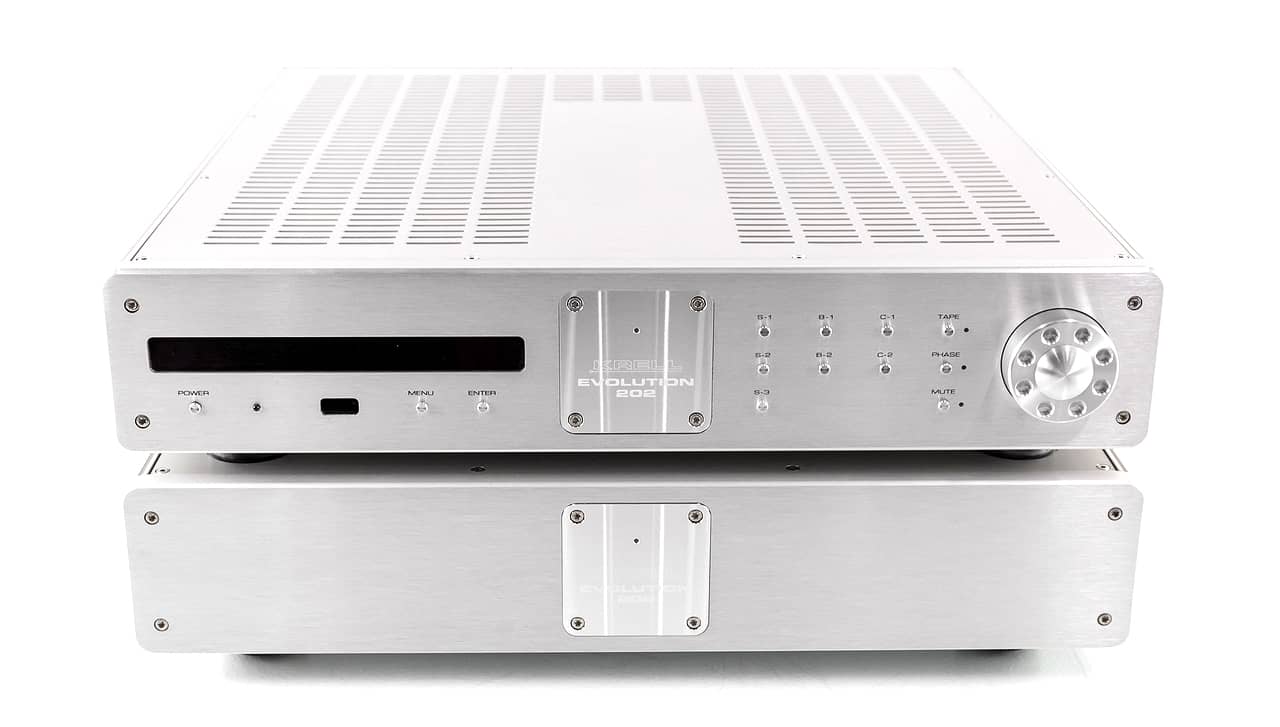
Evolution 202 stereo preamplifier
Not surprising the reviewer was reaching for his most effusive color commentary to describe an impressive Krell experience. The company founded on doing big things in big ways has always elicited these kinds of big responses from listeners at demonstrations.
Krell’s innovations over the years in digital playback also produced memorable products. The MD-1 “CD Turntable” produced at the start of the ‘90s decade, when paired with its SPB-64x processor, engaged software-enabled 64-times oversampling of the signal via advanced Motorola chips. This was a forward-thinking approach that would exemplify the American brand’s efforts in this sector.
Throughout the 2000s and into the following decade, Krell grew their digital sector to attack the home theater scene with typical Krell-like vigor. Clean, high-Class-A-bias amplifiers with wide bandwidth were employed in the multichannel designs, and power supplies drew from Krell’s previous efforts to profound effect. Most recently in the home theater lineup, Krell’s XD output impedance advancements have blown the minds and satisfied the ears of reviewers and movie watchers alike. Krell today makes a large range of multichannel amplifiers and advanced digital processors that touch the state of the art.
But overall in recent times in the company’s journey, the focus has shifted back to exemplifying the cream of the 2-channel audio crop. The introduction in the last few years of Krell’s latest proprietary technologies, iBias and XD, brought a new wave of Class A products to the company’s rich history of implementation of the style of amplification.
iBias builds on many previous attempts to create a “sliding bias” in amplification, and a more fine-tuned approach than the Sustained Plateau of yesteryear. Earlier attempts by other companies at modulating the amount of Class A operation in an A/B amplifier were tied to the input signal, and suffered from sluggish speed and inaccurate thresholds not based on the speaker load. iBias instead incorporates the speakers’ needs and studies the outgoing current to quickly adjust the bias up or down for constant Class A audio while lowering energy use and heat dissipation. This has proved in detailed measurements and published reviews to be a much more effective way to keep amplification running in Class A all the time, except in extreme situations on absurd speaker loads.
Krell’s most recent trademarked innovation, XD, keeps the output impedance extremely low across all of the company’s amplifier circuits. The engineering team was able to manage transient and stability issues of this by cleverly organizing and redesigning the output circuitry. Lower output impedance equates to better grip on the woofers of connected speakers, and higher resolution in the bottom frequencies of music.
The first current Krell model to contain this advancement was the amazing do-it-all integrated amplifier in the lineup, the Krell K-300i. Its iBias circuitry makes the first 90 watts produced pure Class A, and together the two innovations create a memorable product even against the rich tapestry of memorable products from the famous brand. We’ve got an upcoming review of the versatile showpiece, but it is hardly the top of the modern offerings featuring the new XD tech.
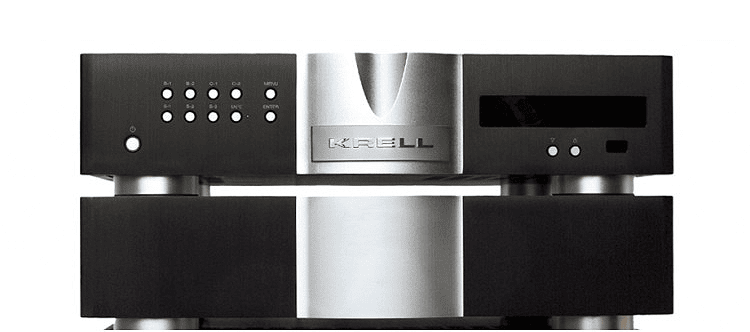
Krell’s Illusion preamplifier line also carries on much of the tradition of the early statement pieces. It delivers reference-level “Current Mode” preamplification, offers staggeringly wide bandwidth typical of their top preamplifiers, and incorporates a zero-feedback design. Of course, the audio circuit is dual mono with a separate power supply unit for the lowest self-noise possible. It wouldn’t be a Krell preamplifier if it didn’t have a special supply and clever engineering behind it. Reviews gush about the Illusion’s top-to-bottom supremacy as a high-end separate.
The Connecticut-based company is clearly back in the forefront of the American HiFi scene, and continues its quest for the mountaintop of high end audio reproduction. Krell’s determination that Class A amplification offers the purest form of musical playback has endured throughout its time as one of HiFi’s top producers. The Master Reference Audio Standard products will stand in history as some of the most impressive ever made. To many who began their journey in HiFi with one of the beloved KSA amplifiers, Krell will occupy a special place in the heart. To our educated eyes and ears, the American company itself has always been, and still is, Class A all the way.
